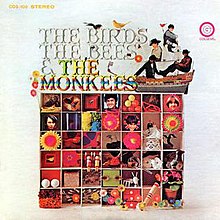The Birds, The Bees & The Monkees
| The Birds, The Bees & The Monkees | ||||
|---|---|---|---|---|
 |
||||
| Studio album by The Monkees | ||||
| Released | April 22, 1968 | |||
| Recorded | Late 1967–early 1968 | |||
| Genre | Pop rock, baroque pop, psychedelic pop | |||
| Length | 37:00 | |||
| Label |
Colgems (original U.S. release) RCA Victor (original release outside U.S.) Arista (1980 Japanese LP reissue + 1986 CD reissue) Rhino (1985 LP reissue + 1994 & 2010 CD reissues) Sundazed (1996 LP reissue) |
|||
| Producer | The Monkees, Chip Douglas | |||
| The Monkees chronology | ||||
|
||||
| Singles from The Birds, The Bees & The Monkees | ||||
|
||||
| Professional ratings | |
|---|---|
| Review scores | |
| Source | Rating |
| AllMusic | |
| MusicHound | |
| popdose | (favorable) |
| Record Collector | |
| The Rolling Stone Album Guide | |
The Birds, The Bees & The Monkees is the fifth studio album by The Monkees released in April 1968. It was the first Monkees album not to reach Billboard's number one, peaking at No. 3 in the U.S. charts. It was also their first album to miss the UK charts altogether, with their four previous efforts all having reached the top ten. The album has sold over a million copies.
Despite the band's hardships in 1968 (their television series was canceled; their first motion picture project, Head, failed at the box office; and in December, Peter Tork left the group), The Birds, The Bees & The Monkees proved to be another successful album, yielding the group's sixth million-selling single in "Valleri" and yet another No. 1 in "Daydream Believer," written by former Kingston Trio member John Stewart. Coincidentally, both songs had been holdovers from previous albums: "Valleri" had originally been recorded more than a year prior for the television show (the version on this album is a new production) and "Daydream Believer" had been recorded for their previous album, Pisces, Aquarius, Capricorn & Jones Ltd.. "Tapioca Tundra," an experimental piece of poetry put to music by Nesmith, charted well as the B-side to "Valleri" and reached No. 34.
After gaining complete artistic control over their musical direction and being allowed to play instruments on their own records in early 1967, the success of Headquarters and Pisces, Aquarius, Capricorn & Jones Ltd. began to somewhat rebuff the critics who viewed The Monkees as a band of talentless individuals who were simply lucky enough to gain recognition through their "manufactured" origins.
The desire and focus, however, to remain as a complete band unit in the studio evaporated after the Pisces album, when each individual band member began to produce his own sessions with his own selected studio musicians, often at entirely different studios around the Los Angeles area. An agreement was made to label all finished efforts as "Produced by The Monkees," but in reality, beyond a few exceptions, most of the recordings featured on The Birds, The Bees & The Monkees revert to the recording process of the first two albums (fewer group dynamics), except now each band member was fully in charge of the sessions. Chip Douglas, producer of The Monkees' previous two albums, fully expected to continue as the band's representative in the studio, but found the individual Monkees more interested in exploring their diverse musical backgrounds with their own friends and associates rather than relying on Douglas as the central figure.
...
Wikipedia
